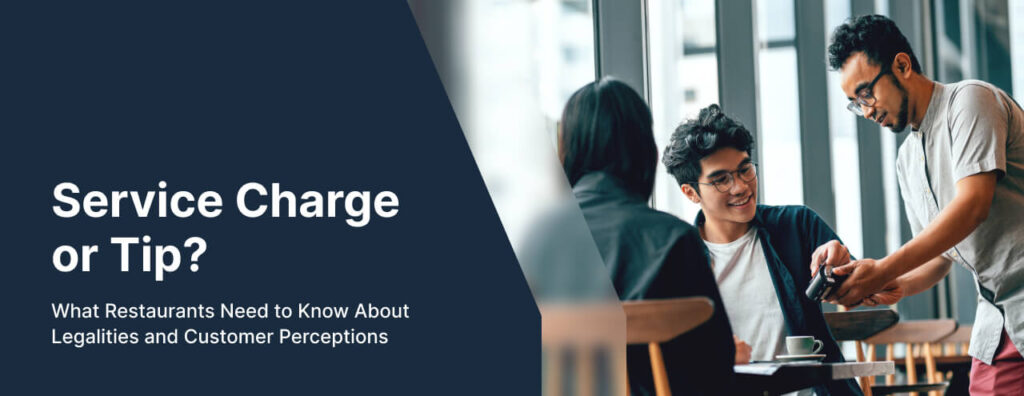Service Charge or Tip? What Restaurants Need to Know About Legalities and Customer Perceptions

The restaurant and foodservice industry is an integral part of the U.S. economy, providing 15.5 million jobs as the country’s second-largest private sector employer. But as anyone who works in the business knows, there are no shortages of challenges, including inflation, labor shortages, and supply chain disruptions. For example, wholesale food prices are up 13%, and as a way to boost profitability and supplement employee earnings, many restaurants have started implementing service charges.
A service charge is different from a tip, and the topic can be both contentious and controversial. In this guide, we’ll explain the differences, the laws pertaining to both, and how service charges can impact your employees, customers, and accounting practices.
What Is a Service Charge at a Restaurant?
A service charge is a mandatory fee that’s added to a customer’s bill. It’s important to stress that a service charge is not a tip, and the restaurant reserves the right to use this money however they’d like. In some cases, the money is often returned to the employees as part of their wages, but it is not required.
Service charges are typically included for large parties, banquet events, cruise trip packages, hotel rooms and bottle service charges at nightclubs and restaurants. It is usually calculated as a percentage of the bill’s total.
A tip, on the other hand, is money that a customer provides to an employee as a token of appreciation for their service. This is optional and discretionary.
Approximately 15% of restaurants have imposed service charges, and many do so for a variety of reasons: To supplement employee earnings, balance the cost of food and other expenses, and compensate for an increased workload when catering to a large party.
A service charge may also be known as a service fee, kitchen fee, or economic impact fee.
Service Charges vs. Automated Gratuities
Automated gratuity is another term that’s closely associated with service charges and tipping. It’s defined as a predetermined percentage of the total amount that’s added to the bill for large parties — typically at least six or eight people.
There may be some confusion about whether automated gratuities are similar to tipping in that they are optional, but in January 2014 the IRS began classifying automated gratuities as service charges, which means they are non-tip income and count toward the employee’s wage earnings on payroll reports.
Whether an automated gratuity is the same as a tip may also be up to the restaurant. Some restaurants will automatically improve a gratuity for a party of a certain size (and will make this clear with signage on the tables and menu). Some restaurants, however, have certain policies in place where it’s up to the server or restaurant’s discretion to impose an auto gratuity but only for parties of particular sizes.
The bottom line is that guests have the right to refuse an automated gratuity, which goes to the employee. If an automated gratuity is imposed, the server knows they will likely not receive any additional tips, and it’s usually capped around 15%–20%.
What Are the Laws Regulating Service Charges and Tips?
According to federal law, employers of tipped employees must pay a direct wage of $2.13 per hour as long as the combined amount of tips and the direct wage equals (or exceeds) the federal minimum wage.
Tipping laws and service charge laws vary by state. For example, Initiative 82, a ballot measure in Washington, D.C. that passed in 2022, is phasing out the tipped minimum wage. From 2022–2027, employers will pay their employees increasingly more ($8/hour in July 2023 and $2 more every year until 2027 when the pay will reach full minimum wage at $17/hour). The District of Columbia also has restaurant fee disclosure requirements that must comply with D.C.’s Consumer Protection Laws.
California recently passed a state law that bans unadvertised service fees. Restaurants will still be able to advertise these charges and other menu feeds, but they must be included in the menu prices.
How Service Charges Impact Staff and Payroll
Are you considering implementing a service charge? Here are some common ways this type of mandatory fee may impact your staff and payroll:
- You can use service charges to supplement staff earnings, but ultimately it’s up to you. If you choose to pursue that option, employee salaries can achieve more stability as opposed to the variability that comes with tipping.
- Customers may think that service charges are tips and will therefore not feel compelled to leave anything.
- Employees may not feel as motivated to provide excellent service if their income does depend on customer tipping. Many restaurants, however, usually adjust employee income if tips are affected by service charges so that a portion of the fee goes directly to the servers.
- Service charges, similar to tips, are an additional type of payment that payroll managers must account for. Typically, service charges will have their own calculation for their distribution types.
- Union collective bargaining agreements will ensure that employees are earning a percentage of service charges.
Tips for Communicating Service Charges to Customers
If you elect to have a service charge, it’s important that you convey this clearly to your customers. Make sure your policy is visible and easily accessible on your website, menu, and any other customer-facing communication. Customers should know there is a service charge (and what exactly it covers) before placing an order. Just anticipate that customers may have questions, and in some cases, objections.
This type of clear communication will also benefit your staff so as to avoid any type of potential issues or misunderstandings, which is exactly what happened in a recent lawsuit at a popular California eatery, Jon & Vinny’s.
Former servers filed a class-action lawsuit alleging that the restaurant violated state gratuity laws because of unclear language around its service fee. The servers believed the restaurant was tricking its customers into thinking the service fee was actually a tip when it wasn’t. Jon & Vinny’s has since updated its disclaimer to read: “The service charge is not a tip or gratuity, and is an added fee controlled by the restaurant that helps facilitate a higher living base wage for all of our employees.”
What Are Restaurants Doing? [Case Studies & Examples]
The majority of restaurants don’t have a service charge, but more have started implementing them in recent years. Other establishments are raising food prices instead or trying to cut costs and increase profit in other ways. If you are thinking about implementing a service charge, it’s important to make sure your policy follows all federal and state guidelines and legal requirements.
Here are some real-life examples of service fee language:
- “At Alinea Group Restaurants, we include a 20% service charge as part of your experience. The service charge ensures that all of our employees are paid a fair wage and receive benefits all year long. Additional gratuity paid on the evening of your reservation is at the discretion of each guest. 100% of discretionary tips are paid to non-salaried, Front of House employees.” — The Aviary, Chicago, IL
- “Here at Surly, we’ve joined many local and independent restaurants in replacing tipping–a practice that goes 100% to your server–with a 20% surcharge that supports higher and more equitable wages for all team members, removing tips as a necessity for earning a comfortable income. It also allows us to provide a wide range of benefits to our full-time employees.” Surly Brewing Co., Minneapolis, MN
So, how do customers feel about service charges? Not surprisingly, many are opposed to the idea, with half of customers saying they would be less likely to return to a restaurant that charges a 20% service fee.
In a recent Restaurant Business article, Robert Byrne, director of consumer insights at Technomic, was quoted as saying: “The understanding that a consumer has when they come to the restaurant is there’s a price on the menu, and that’s the price I should expect to pay.” He explained that adding fees “runs the risk of making the consumer apoplectic. You feel like you’re paying a cable bill.”
Looking to Elevate Your Gratuity Management Game?
There are a lot of details and nuances when it comes to tipping, service charges, and automated gratuities, which is why it’s crucial to understand not only your legal requirements but also which services and solutions can help ensure compliance, business efficiency, and overall employee satisfaction.
Our eBook, The Win-Win of Automation: How Automation in Gratuity Distribution Benefits Both Employers and Employees, explores the benefits of automation for tip-based businesses and provides tips for selecting the solution that’s right for you.


